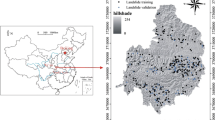Abstract
By applying the GIS spatial analysis function, 547 sites in Kashgar of Xinjiang before the Ming and Qing dynasties were selected as research objects, 540 non-site points were generated using GIS spatial analysis method. Geographical environment variables such as the elevation, slope, orientation, land-cover types, degree of relief, distance to the ridge line, distance to the valley line and the distance to the river of the site and non-site points were obtained respectively. 274 site points and 270 non-site points were randomly selected as training set, the logistic binary regression analysis was used to establish a site prediction model. Cross-validation and Kvamme's gain statistics method were adopted to verify the model accuracy. The result showed that: the overall prediction accuracy of the model is 70.29%, the prediction ability of the non-site points in the low probability area is strong, and the prediction ability of the site points in the high probability area is strong too. It can provide reference for field archaeological investigation, archaeological research and cultural heritage protection.
Access this chapter
Tax calculation will be finalised at checkout
Purchases are for personal use only
Similar content being viewed by others
References
Willey, G.R: Prehistoric settlement in the Virú Valley, Peru. Bureau of American Ethnology Bulletin 155, Washington (1953)
Green, E.L.: Location analysis of prehistoric Maya sites in Northern British Honduras. Am. Antiquity 38, 279–293 (1973)
Kvamme, K.L.: Computer processing techniques for regional modeling of archaeological site locations. Adv. Comput. Archaeol. 1, 26–52 (1983)
Kvamme, K.L.: Development and testing of quantitative models.Judge J W, Lynne Sebastian. Quantifying the Present and Predicting the Past: Theory, Method and Application of Archaeological Predictive Modelling. U. S. Department of Interior, Bureau of Land Management. Denver, pp. 325–428(1988)
Kohler, T.A., Parker, S.C.: Predictive models for archaeological resource location. Adv. Archaeol. Method Theory. 9, 397–452 (1986)
Judge, J.W., Sebastian, L.: Quantifying the present and predicting the past: theory, method and application of archaeological predictive modelling. U. S. Department of the Interior, Bureau of Land Management, Denver (1988)
Ni, J.S.: Prediction model of archaeological sites in the upper reaches of the Shuhe River in Shandong. Progr. Geogr. 28(04), 489–493 (2009). 倪金生.山东沭河上游流域考古遗址预测模型. 地理科学进展 28(04), 489–493 (2009)
Peng, S.Z., Zhang, W., Chen, D.D.: Model prediction of dawenkou culture archaeological site in wensi valley. J. Taishan Univ. 32(06), 34–39 (2010). 彭淑贞,张伟,陈栋栋.汶泗流域大汶口文化考古遗址模型预测. 泰山学院学报 32(06), 34–39 (2010)
Qiao, W.W., Bi, S.B., Wang, Q.F., Guo,Y.: Prediction model of Longshan cultural site in Zhengluo area. Sci. Surv. Mapp. 38(06), 172–174+181 (2013). 乔文文,毕硕本,王启富,郭忆.郑洛地区龙山文化遗址预测模型. 测绘科学 38(06), 172–174+181 (2013). https://doi.org/10.16251/j.cnki.1009-2307.2013.06.023
Dong, Z., Jin, S.Z.: Prediction research on Bohai Kingdom ruins in Yanbian area based on the logic regression model. J. Yanbian Univ. (Nat. Sci.) 41(02), 179–184 (2015). 董振,金石柱.基于Logistic回归模型的延边地区渤海国遗址预测研究. 延边大学学报(自然科学版) 41(02), 179–184 (2015). https://doi.org/10.16379/j.cnki.issn.1004-4353.2015.02.018
Cao, Y.W.: Prediction model of ante-qin dynasty sites in conghua liuxi river basin based on logistic regression analysis. Geomat. Spat. Inf. Technol. 44(05), 124–127+131 (2021). 曹耀文.基于Logistic回归分析的从化流溪河流域先秦时期遗址预测模型. 测绘与空间地理信息 44(05), 124–127+131 (2021)
National cultural heritage administration.: Atlas of Chinese Cultural Relics, Xinjiang Uyghur Autonomous District Book. Cutural Relics Press, Beijing (2012). 国家文物局. 中国文物地图集,新疆维吾尔自治区分册. 文物出版社 (2012)
Wu, B.F., Yuan, Q.Z., Yan, C.Z., et al.: The land-cover changes in the first ten years of the 21st century in China. Quat. Res. 34(4), 723–731 (2014). 吴炳方, 苑全治, 颜长珍, 王宗明, 于信芳, 李爱农, 马荣华, 黄进良, 陈劲松, 常存, 刘成林, 张磊, 李晓松, 曾源, 包安明. 21世纪前十年的中国土地覆盖变化. 第四纪研究 34(4), 723–731 (2014)
Zhang, L., Jia, K., Li, X., Yuan, Q., Zhao, X.: Multiscale segmentation approach for object-based land-cover classification using high-resolution imagery. Remote Sensing Letters 5(1), 73–82 (2014)
Zhang, L., Wu, B.F., Li, X.S., et al.: China land-cover classification system based on carbon budget. Acta Ecologica Sinica 34(24), 7158–7166 (2014). 张磊,吴炳方,李晓松,邢强.基于碳收支的中国土地覆被分类系统.生态学报 34(24), 7158–7166 (2014)
Tang, G.A., Yang, X.: ArcGIS Geographic Information System Spatial Analysis Experiment Tutorial. China Science Press, Beijing (2012). 汤国安, 杨昕. ArcGIS 地理信息系统空间分析实验教程. 科学出版社 (2012)
Kvamme, K.L.: The fundamental principles and practice of predictive archaeological modeling. In: Mathematics and Information Science in Archaeology: A Flexible Framework, Bonn, pp. 257–295 (1990)
Vaughn, S., Crawford, T.: A predictive model of archaeological potential: an example from northwestern Belize. Appl. Geogr. 29(4), 542–555 (2009)
Author information
Authors and Affiliations
Corresponding author
Editor information
Editors and Affiliations
Rights and permissions
Copyright information
© 2022 The Author(s), under exclusive license to Springer Nature Switzerland AG
About this paper
Cite this paper
Jiang, W., Gao, H. (2022). Research on the Prediction Model of Sites in Kashgar Based on Logistic Regression Analysis. In: Wu, H., et al. Spatial Data and Intelligence. SpatialDI 2022. Lecture Notes in Computer Science, vol 13614. Springer, Cham. https://doi.org/10.1007/978-3-031-24521-3_13
Download citation
DOI: https://doi.org/10.1007/978-3-031-24521-3_13
Published:
Publisher Name: Springer, Cham
Print ISBN: 978-3-031-24520-6
Online ISBN: 978-3-031-24521-3
eBook Packages: Computer ScienceComputer Science (R0)




